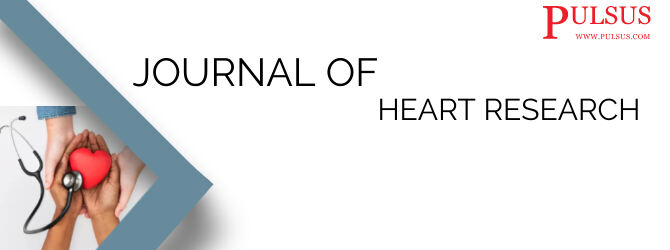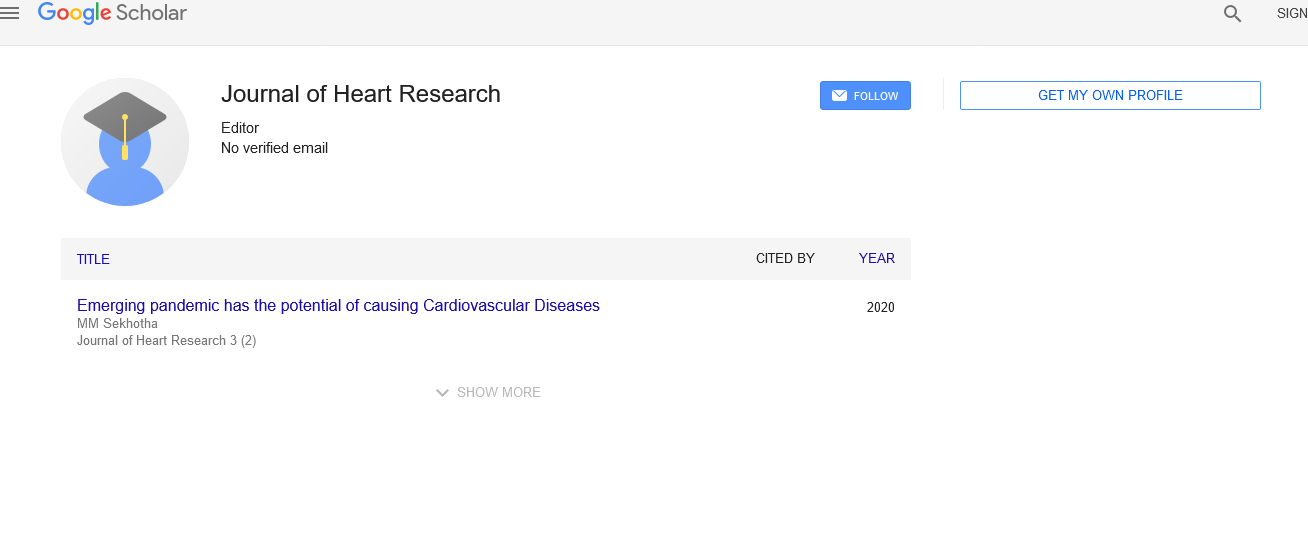Cardiomyopathies associated with COVID-19 infection
Received: 06-Aug-2022, Manuscript No. puljhr- 22-5325; Editor assigned: 10-Aug-2022, Pre QC No. puljhr- 22-5325 (PQ); Accepted Date: Sep 06, 2022; Reviewed: 24-Aug-2022 QC No. puljhr- 22-5325 (Q); Revised: 01-Sep-2022, Manuscript No. puljhr- 22-5325 (R); Published: 08-Sep-2022, DOI: 10.37532/ puljhr.2022. 5(4).01-03.
Citation: Roato F, Cardiomyopathies Associated with COVID-19 Infection. Int J. Heart Res. 2022; 5(4):1-3.
This open-access article is distributed under the terms of the Creative Commons Attribution Non-Commercial License (CC BY-NC) (http://creativecommons.org/licenses/by-nc/4.0/), which permits reuse, distribution and reproduction of the article, provided that the original work is properly cited and the reuse is restricted to noncommercial purposes. For commercial reuse, contact reprints@pulsus.com
Abstract
Worldwide viral disease COVID-19 infection has a notably high risk of morbidity and fatality. Numerous systems are impacted by this illness. The involvement of the cardiovascular system ranks highly among these systems. Arrhythmias play a significant role in the involvement of the cardiovascular system. Arrhythmias can occur as a result of viral toxicity, secondary issues, and medications. Treatment involves changing the underlying mechanism, which is crucial. We discuss cardiac arrhythmia in COVID-19 infection because of its significance. The aim of this study was to assess the risk of cardiac arrest and arrhythmias such as incident Atrial Fibrillation (AF), bradyarrhythmias, and Nonsustained Ventricular Tachycardia (NSVT) in a sizable metropolitan population hospitalized for COVID19. We also looked at links between the occurrence of these arrhythmias and death. The ongoing Coronavirus Disease 2019 (COVID-19) pandemic is caused by the severe acute respiratory syndrome coronavirus 2 (SARS-CoV-2). Arrhythmia is one of the most feared cardiac problems associated with COVID-19. There are numerous recorded cases of this. The etiology of the arrhythmia caused by COVID-19 is being investigated in numerous ongoing investigations. We still know very little about the precise workings of the latter, though. Direct or indirect endomyocardial tissue injury may be a factor in the underlying potential pathways.
Keywords
Arrhythmia; Morbidity; Mortality; Atrial fibrillation; Cardiac arrest
Introduction
umerous investigations have also observed that cardiac N arrhythmias are not just a direct result of COVID-19 infection but also result from systemic disease, proarrhythmic medicines, and electrolyte abnormalities in hospitalized individuals. In this review paper, we discuss the various facets of arrhythmias in COVID patients as well as potential co-morbidities and triggers. We thoroughly examined every health record to determine the demographics and medical comorbidities. We also kept track of the admission profile, which had information on vital signs, lab results, and antiviral drugs used while the patient was in the hospital. Age, sex, and race were among the demographic factors [1]. Heart failure, hypertension, a history of AF, diabetes, obstructive sleep apnea, chronic obstructive lung disease, chronic liver disease, and chronic renal disease were among the comorbid conditions. Coronary heart disease is defined as Coronary Artery Disease or myocardial infarction (CKD). Temperature, oxygen saturation, and body mass index were all included in the admissions information. White blood cell count and electrolyte concentrations (potassium and magnesium) were basic laboratory measurements. Troponin, B-type natriuretic peptide, D-dimer, procalcitonin, and high-sensitivity C-reactive protein quantities were also measured [2].
This illness causes pneumonia by affecting the lungs. The heart, however, is also negatively impacted by it. This virus has been reported to produce harmful cardiovascular consequences, including myocardial damage, thromboembolic events, and deadly arrhythmias. A study found that 44% of people with severe COVID-19 conditions had arrhythmia. These factors, together with others, explain why COVID-19 infection raises the risk of morbidity and mortality. We have provided this material as a result of this elevated risk. The RNAdependent RNA polymerase enzyme is responsible for its replication inside the cell. By the same mechanisms, it also gets within the cells of the heart's layers [3].
Acute respiratory distress syndrome, which occurs in the lungs, can lead to arrhythmia with hypoxia. As a result of hypoxia, the tissue anisotropy, depolarization threshold, and electrical coupling are all altered. Infection of the myocardial cell by a virus and damage caused by immune cells may result in myocarditis. The physiopathology of myocarditis is significantly influenced by the cytopathic effect and the post-inflammatory cardiac scar. After that, electrical imbalance and reentry may cause arrhythmias to form. The RNA-dependent RNA polymerase enzyme is responsible for its replication inside the cell. By the same mechanisms, it also gets within the cells of the heart's layers [4].
The medical records of each patient were also examined to check for cardiac arrest or arrhythmias. We specifically checked the telemetry logs, nursing notes, and doctor's notes for cardiac arrests and arrhythmias like incident AF, bradyarrhythmias, and NSVT for all patients. The incident AF analysis did not include patients having a history of AF. Bradyarrhythmias were identified as clinically significant instances of bradycardia accompanied with hypotension. We additionally verified that a medical procedure was carried out in these circumstances. For cardiac arrests, we noted whether the initial rhythm recorded was VF, VT, sinus bradycardia, heart block, asystole, or pulseless electrical activity [5].
ARRHYTHMIAS AND TREATMENT
Infection with COVID-19 can result in autonomic dysfunction, which can lead to sinus tachycardia, postural orthostatic tachycardia, and supraventricular tachycardia. In the case of unexplained inappropriate sinus tachycardia, secondary causes such as pulmonary embolism, anaemia, hypotension, hyperthyroidism, and fever should be ruled out. Inappropriate sinus tachycardia can be diagnosed using event recorders and Holter electrocardiography. Beta-blockers have been found to be effective in the treatment, but ivabradine's advantages are unclear. Postural orthostatic tachycardia syndrome may be diagnosed with the tilt table test. Following troponin normalisation, normalisation of imaging techniques, and infection resolution, these individuals should take a vacation from competitive sports for a period of three months to six months. Supraventricular tachycardia secondary causes should be ruled out [6]. These findings give rise to worries that subsequent cardiac damage and SARS CoV-2 infection may enhance the incidence of arrhythmia. In a sizable urban patient group hospitalised for COVID-19, we intended to systematically assess the risk of cardiac arrest and arrhythmias such as incident Atrial Fibrillation (AF), bradyarrhythmias, and Nonsustained Ventricular Tachycardia (NSVT). Additionally, we looked at links between cardiac arrhythmias and acute in-hospital mortality. Atrial arrhythmias are the most typical arrhythmias associated with COVID-19 infection. Atrial flutter and fibrillation can both be brought on by systemic inflammation. Atrial arrhythmias can also be brought on by hypoxia, metabolic issues, electrolyte imbalances, cardiac ischemia, and the side effects of proarrhythmic medications. If a patient has restrictive and constrictive pulmonary lung disease, beta-blockers should be administered with caution in patients with atrial fibrillation and atrial flutter. The use of amiodarone in people who develop fibrotic pulmonary illness needs to be taken into consideration. If procedures like transesophageal echocardiography and intubation will be performed, protective equipment should be utilised to reduce contamination. To rule out thrombus prior to cardioversion, cardiac computed tomography is an alternative. Regarding these individuals' COVID risk, we advise using anticoagulants [7].
Atrioventricular block could result from atrioventricular nodal damage. The usage of azithromycin, lopinavir/ritonavir, and hydroxychloroquine may result in bradycardia. Bradycardia brought on by lying flat or tracheal secretion can be noticed which causes a brief rise in vagal activity. Patients with symptomatic bradycardia, patients with high-grade atrioventricular block, or patients with total atrioventricular block should have their pacemakers replaced. Ventricular tachycardia or ventricular fibrillation may result from thrombosis and myocarditis. Secondary factors include acute coronary syndrome, acute pulmonary embolism, cerebrovascular events, and drug usage might result in ventricular tachycardia or ventricular fibrillation. When treating bronchospasm-induced hypoxia, beta-blockers should be used carefully. In the event of Torsades de Pointes tachycardia, magnesium infusion may also be employed. When polymorphic ventricular tachycardia is suspected to be caused by acute coronary syndrome, coronary reperfusion, and intravenous beta blockers are crucial, especially. Implantable cardioverter defibrillators are not well supported by evidence [8].
Discussion
Cardiac arrhythmias were more likely to develop in patients who had more severe systemic disease as indicated by ICU admission. After taking into consideration demographic and clinical variables, such as underlying cardiovascular risk factors and disease between patients admitted to the ICU and those admitted to a non-ICU setting, the link with bradyarrhythmias could be explained. The continuous, independent relationship between ICU hospitalisation and incident AF and NSVT, on the other hand, probably has an unmeasured cause that is related to the severity of the illness. Recent research from the University of Alabama in Birmingham confirms that people in ICUs are more likely to experience atrial arrhythmias than people in other settings. These reliable results ought to draw attention to issues with long-term anticoagulant medication. COVID-19 can cause arterial and venous thrombosis, among other thrombotic effects. Endothelial cells infected with SARS-Cov-2 are thought to respond by releasing cytokines, which in turn trigger endothelial and hemostatic activity.
Particularly when AF is present, this inflammatory condition may raise the risk of thromboembolic consequences. Future research will need to assess the most efficient and secure methods for rhythm management and long-term anticoagulation in this population. A single facility that serves a sizable urban population conducted this investigation. Therefore, it's possible that patients with COVID-19 from throughout the world wouldn't be able to generalise our findings. Additionally, some patients in the non-ICU ward had their telemetry removed while they were being treated at the hospital. As a result, we wouldn't be able to fully detect subclinical arrhythmias in these patients. Finally, we limited our study to inpatient follow-up solely. Because of this, we are unable to determine if the occurrence of arrhythmic events has an impact on the long-term health of our patients who had COVID-19 treatment.
References
- Alshamam MS, Nso N, Idrees Z, et al. Coronavirus disease 2019 (COVID-19)-induced Takotsubo cardiomyopathy prognosis in geriatric setting. Cureus. 2021 Jul 6;13(7).
- Goette A, Patscheke M, Henschke F, et al. COVID-19-induced cytokine release syndrome associated with pulmonary vein thromboses, atrial cardiomyopathy, and arterial intima inflammation. TH Open. 2020 Jul;4(03):e271-9.
- Haussner W, DeRosa AP, Haussner D, et al. COVID-19 associated myocarditis: A systematic review. Am J Emerg Med. 2022 Jan 1;51:150-5.
- Hammersley DJ, Buchan RJ, Lota AS, et al. Direct and indirect effect of the COVID-19 pandemic on patients with cardiomyopathy. Open heart. 2022 Jan 1;9(1):e001918.
- Desai HD, Sharma K, Jadeja DM, et al. COVID-19 pandemic induced stress cardiomyopathy: a literature review. International Journal of cardiology. Heart Vasc. 2020 Dec;31.
- Roca E, Lombardi C, Campana M, et al. Takotsubo syndrome associated with COVID-19. Eur j case rep intern med. 2020;7(5).
- Jani C, Leavitt J, Al Omari O, et al. COVID-19 vaccine–associated Takotsubo cardiomyopathy. Am. J. Ther. 2021 May 1;28(3):361-4.
- Garg S, Singh A, Kalita M, et al. Peripartum cardiomyopathy mimicking COVID-19 infection. J Anaesthesiol Clin Pharmacol. 2020 Aug;36(Suppl 1):S44.





